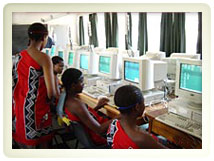There are gender wars, and then there are casualties. It wasn’t until 2011 that the behemoth toymaker LEGO acknowledged girls’ desire to build with bricks, even though the company had long before made a seemingly effortless pivot to co-branding, video games, and major motion pictures. So it’s little wonder that girls face all-too-real obstacles when […]
Read moreStepping into emerging markets with informational infrastructure.
 An “obsolete” computer in the West might be useful and well-received by poorer communities. |
Problem
The digital divide that exists between those with access to technology and those without is exacerbated by the constant improvements – revisions and upgrades – generated by software developers and hardware manufacturers in order to increase profitability. Newer and better functions, features, and computing speeds drive costs and complexity higher and further out of reach for those who don’t have access to basic technology.
 Sixth-form students in Swaziland enjoying their new computer lab. Computer Aid International moves warehoused equipment into the hands of recipient organization overseas. Although finding good enough hardware can be a challenge, it’s even more of a challenge to establish conduits to deliver donated items to underserved areas and organizations able and willing to use them. Compounding the problem is that some recycled computers have negative value: not only are they too expensive to refurbish, but they are also toxic. |
Solution
In order to solve the digital divide, software and hardware vendors must reassess their corporate values and embrace emerging markets that currently do not have access to technological resources. Furthermore, because the computer industry systematically ignores this “non-consuming” market, the public sector and NGOs must step in to provide equipment and lay the foundations for local communities to build infrastructures of people and resources that can sustain technological advancement.
Discussion
While the PC hardware and software industries are continuing to upgrade their offerings, their market growth has slowed considerably. Since 2000, the industry has seen single digit growth and even periods of decline in volume and value of sales.
The only potential area of significant growth has been in so-called emerging markets, yet PC vendors have not been motivated to serve these areas. Paradoxically, in markets where PCs are rare, mobile phones are abundant; the ratio of PC to phone ownership is less than 1:10.
Although the opportunity exists for the PC industry to triple in size, vendors are actively avoiding these markets. In order to do so, manufacturers would have to sell PCs at a fraction of what is currently considered profitable. The computers would also need to be more rugged and easier to use in environments where there is little supporting infrastructure. Interestingly, these constraints have not hampered the growth of the mobile phone in the same markets.
  An example of a “good enough” solution: The MIT Media Lab, a think tank for innovations designed to serve radically new environments than those for which information technology was designed, is working on a $100 laptop, crank-operated for use in areas without electricity. The device is part of the One Laptop per Child (OLPC) initiative, first announced by Nicholas Negroponte, Lab chairman and co-founder, at the 2005 World Economic Forum in Davos, Switzerland. |
Can a PC be as Popular as a Mobile Phone?
In the PC market, companies profit from upgrading powerful systems for their wealthiest customers. As such, it’s been impossible to motivate them to offer low margin, good enough functionality to non-customers through new distribution networks. A company’s resources, processes, and value system simply prohibit addressing low-end needs. Not only do managers fail to see the value logic in such a plan, but employees refuse to work on such projects and shareholders revolt at shrinking profit margins.
On the other hand, mobile phone makers solved this problem by creating specific price-conscious products and service plans around prepay, messaging, and other services. The solutions have been indigenous: local operators designed and built service plans, offered support, and distributed prepay vouchers. Mobile phone production was also moved close to the consuming markets.
MIT has proposed an analogous plan for PCs. The One Laptop per Child (OLPC) initiative addresses the education market, offers government-sponsored equipment, and expects local service to quickly grow to supply this market.
This last assumption is predicated on the use of open source software. The ability of local software and service systems to emerge is based entirely on the rapid adoption of skills. These skills are easier to acquire when there are few intellectual property restrictions on dissemination.
What’s The Likely Outcome?
OLPC is a good first step on a long road. Mainstream vendors need to learn from both this experiment and the history of the mobile phone, and then to establish local, autonomous organizations to solve the needs of these emerging markets. Such autonomy ensures that local economic realities are not subsumed by vendors’ business models.

